 Conspiracy theories about occult origins of socialism circulate on the Internet. Socialists who have been initiated into freemasonry or accidental similarities between socialist and esoteric iconography are taken as proof of an occult, virtually satanic, genesis of the worker’s movement. Not everything in these far-fetched theories is false however, as the existence of The Noble and Holy Order of the Knights of Labor may indicate. Right now I am in particular curious about the origin of the anarchist A, the one encircled.
Conspiracy theories about occult origins of socialism circulate on the Internet. Socialists who have been initiated into freemasonry or accidental similarities between socialist and esoteric iconography are taken as proof of an occult, virtually satanic, genesis of the worker’s movement. Not everything in these far-fetched theories is false however, as the existence of The Noble and Holy Order of the Knights of Labor may indicate. Right now I am in particular curious about the origin of the anarchist A, the one encircled.
As is well known, the most visible masonic emblem is the G (for God, that at least seems to be the most common exoteric interpretation) in the middle of a square and compasses. Look now at the emblem for the Spanish branch of the First International.* We find in it something  halfway between a pair of compasses and an A – “A” for Asociation/Association, I take it. It’s like the pair of compasses (and maybe the square/ruler) builds the letter. (There is probably also a plumb bob.)
halfway between a pair of compasses and an A – “A” for Asociation/Association, I take it. It’s like the pair of compasses (and maybe the square/ruler) builds the letter. (There is probably also a plumb bob.)
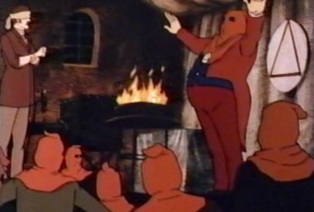 Inspired by the masons, the above-mentioned Knights of Labor used an emblem called Great Seal of Knighthood, depicting simply an encircled triangle. (Here represented in the animated Sherlock Holmes and the Valley of Fear from 1984 as the ominous emblem of The Eminent Order of Freemen.) The triangle is a good start on the way to the letter A as in the anarchist A… After the collapse of the Knights of Labor, the anarcho-syndicalist IWW entered the American radical scene. Was it perhaps in this milleau that the anarchist A was first drawn? Has the anarchist A actually been formed from the freemasonry square and compasses? Or is this only coincidences and the anarchist A actually, as have seen suggested here and there, a later invention, independent of everything esoteric? (Have you noticed the incessant presence of the @? Obviously the covert, miniscule form of the anarchist A, a fact that clearly demonstrates the final, worldwide victory for masonic satanism…)
Inspired by the masons, the above-mentioned Knights of Labor used an emblem called Great Seal of Knighthood, depicting simply an encircled triangle. (Here represented in the animated Sherlock Holmes and the Valley of Fear from 1984 as the ominous emblem of The Eminent Order of Freemen.) The triangle is a good start on the way to the letter A as in the anarchist A… After the collapse of the Knights of Labor, the anarcho-syndicalist IWW entered the American radical scene. Was it perhaps in this milleau that the anarchist A was first drawn? Has the anarchist A actually been formed from the freemasonry square and compasses? Or is this only coincidences and the anarchist A actually, as have seen suggested here and there, a later invention, independent of everything esoteric? (Have you noticed the incessant presence of the @? Obviously the covert, miniscule form of the anarchist A, a fact that clearly demonstrates the final, worldwide victory for masonic satanism…)
Proof!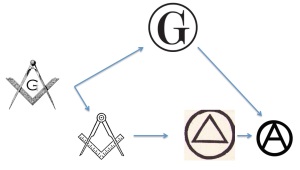
* I’ve tried to check the authenticity of the emblem. The stated source for it is “La masonería y el movimiento obrero: imagos e ideas para una reflexion teórica” by historian Alberto Valín Fernández. Even though I know one or two words in Spanish, reading Galician is not my thing. I however observe that no emblem is reproduced in the article and that we probably should look into ”The Order of Eternal Progress: the quasi-masonic roots of the First International in the United States» by Mark Lause, presented at the conference “’We Band of Brothers’: Freemasonry in radical and social movement 1700-2000” held in Sheffield in 2004.
 I’m uncertain whether the interest in label pins and their history belongs to phaleristics or not. Perhaps phaleristics proper only study symbolic items granted to someone by someone, and not to label pins that you purchase? Until somebody enlightens me on this scholarly obscurity, I will place socialist pins under the label “socialist phaleristics”.
I’m uncertain whether the interest in label pins and their history belongs to phaleristics or not. Perhaps phaleristics proper only study symbolic items granted to someone by someone, and not to label pins that you purchase? Until somebody enlightens me on this scholarly obscurity, I will place socialist pins under the label “socialist phaleristics”.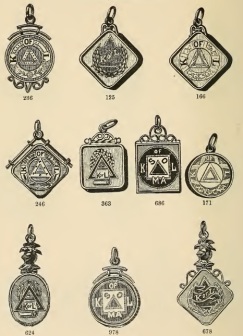 This blog post is decorated with medallions/charms from the Knights of Labor as displayed in F. Irons & Charles A. Russell, Illustrated Catalogue of Solid Gold. Society Emblems, Pins, Buttons and Charms, Providence, Irons & Russell (1895) and a marvellous pin from CNT-FAI that I happend to find on e-bay.
This blog post is decorated with medallions/charms from the Knights of Labor as displayed in F. Irons & Charles A. Russell, Illustrated Catalogue of Solid Gold. Society Emblems, Pins, Buttons and Charms, Providence, Irons & Russell (1895) and a marvellous pin from CNT-FAI that I happend to find on e-bay.
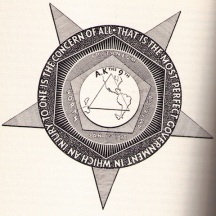 I’m reading the final draft for
I’m reading the final draft for 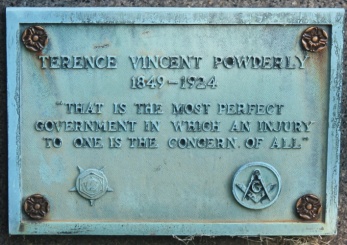


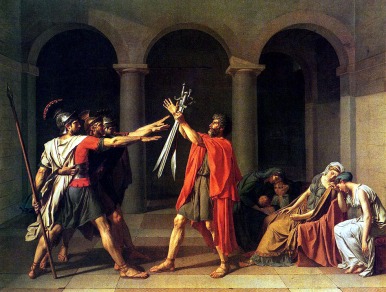 In modern times the so-called Roman salute was immortalized by Jacques-Louis David in his T
In modern times the so-called Roman salute was immortalized by Jacques-Louis David in his T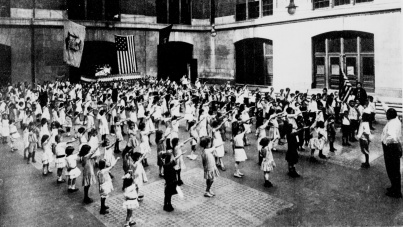
 Conspiracy theories about occult origins of socialism circulate on the Internet. Socialists who have been initiated into freemasonry or accidental similarities between socialist and esoteric iconography are taken as proof of an occult, virtually satanic, genesis of the worker’s movement. Not everything in these far-fetched theories is false however, as the existence of The Noble and Holy Order of the
Conspiracy theories about occult origins of socialism circulate on the Internet. Socialists who have been initiated into freemasonry or accidental similarities between socialist and esoteric iconography are taken as proof of an occult, virtually satanic, genesis of the worker’s movement. Not everything in these far-fetched theories is false however, as the existence of The Noble and Holy Order of the  halfway between a pair of compasses and an A – “A” for Asociation/Association, I take it. It’s like the pair of compasses (and maybe the square/ruler) builds the letter. (There is probably also a plumb bob.)
halfway between a pair of compasses and an A – “A” for Asociation/Association, I take it. It’s like the pair of compasses (and maybe the square/ruler) builds the letter. (There is probably also a plumb bob.) Inspired by the masons, the above-mentioned Knights of Labor used an emblem called Great Seal of Knighthood, depicting simply an encircled triangle. (Here represented in the animated Sherlock Holmes and the Valley of Fear from 1984 as the ominous emblem of The Eminent Order of Freemen.) The triangle is a good start on the way to the letter A as in the anarchist A… After the collapse of the Knights of Labor, the anarcho-syndicalist
Inspired by the masons, the above-mentioned Knights of Labor used an emblem called Great Seal of Knighthood, depicting simply an encircled triangle. (Here represented in the animated Sherlock Holmes and the Valley of Fear from 1984 as the ominous emblem of The Eminent Order of Freemen.) The triangle is a good start on the way to the letter A as in the anarchist A… After the collapse of the Knights of Labor, the anarcho-syndicalist 
 The Holy and Nobel Order of the
The Holy and Nobel Order of the